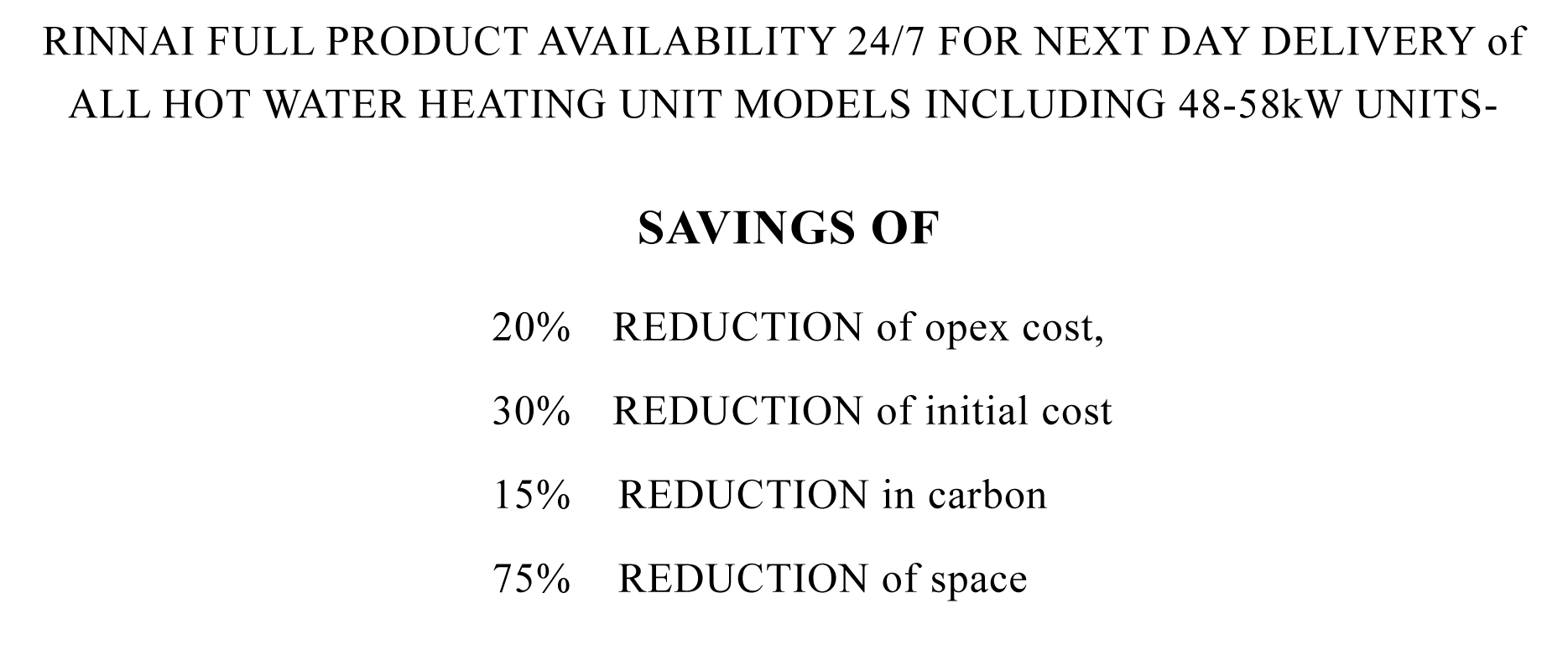IMAGE AND STORY COURTESY OF GRAYSON PRICE
Rinnai High-Efficiency Hybrid Water Heaters: LowER On-Site Emissions AND Meet Peak Demand at West Country Hotel
A West country hotel has just completed the installation of multiple Rinnai blends ready 20% continuous flow water heaters and bespoke Rinnai storage vessels. The Hybrid instantaneous and storage system has been designed to optimise gas usage and satisfy peak demand without wasteful storage oversizing.
The Hydrogen blends ready and BioLPG ready water heaters offer over 2000 lph (litre per hour) of temperature accurate hot water, rapidly replenishing the bespoke hot water vessel to ensure user comfort and satisfaction.
The Rinnai N Series continuous flow hot water heater range offers a more compact, enhanced combustion design that allows for easier installation, superior operational performance as well as ease of serviceability.
The Rinnai Sensei N Series is the first ever continuous flow hot water heating unit manufactured with stainless steel heat exchangers to be available in the UK – this gives an extended working life at optimum performance to each of the four models in the range. Added to this are the market leading extended warranties of up to 12 years in commercial environments, which accompany the hydrogen Blend-ready and Bio-LPG ready instantaneous water heaters.
The four N Series models are:
- N1600i giving 954 litres per hour (at 50 degrees rise)
- N1600e (external) also giving 954 litres per hour (at 50 degrees rise).
- N1300i giving 775 litres per hour and
- N1300e also giving 775 litres per hours of temperature controlled hot water at 50 degrees.
All the range is also low-NOx (Less than 26ppm meaning they gain additional points under BREEAM) and the futureproofed continuous flow water heater utilises Rinnai’s patented advanced burner technology with a 13-1 turn down ratio – the largest on the market combined with 96% efficiency rating. Integral controls on the units enable the water heater to achieve high efficiencies because of advanced burner control and high modulation ranges.
This wide range of modulation means that energy usage is completely optimised as the water heater through smart inbuilt controls will only heat the water to the temperature required thus preserving energy.
Rinnai also offers a full range of unvented and indirect storage cylinders – with capacities from 80 -200L.
Rinnai’s H3 range of products include domestic and commercial heat pumps that offer immediate property decarbonisation. Rinnai is determined to provide UK customers with cost effective low carbon solutions towards domestic and commercial hot water and building heating provision.
RINNAI OFFERS CLEAR PATHWAYS TO LOWER CARBON & DECARBONISATION
PLUS CUSTOMER COST REDUCTIONS FOR COMMERCIAL, DOMESTIC &
OFF-GRID HEATING & HOT WATER DELIVERY
- Rinnai’s range of decarbonising products – H1/H2/H3 – consists of hot water heating units in gas/BioLPG/DME, hydrogen ready units, electric instantaneous hot water heaters, electric storage cylinders and buffer vessels, a comprehensive range of heat pumps, solar, hydrogen-ready or natural gas in any configuration of hybrid formats for either residential or commercial applications. Rinnai’s H1/2/3 range of products and systems offer contractors, consultants and end users a range of efficient, robust and affordable low carbon/decarbonising appliances which create practical, economic and technically feasible solutions.
- Rinnai is a world leading manufacturer of hot water heaters and produces over two million units a year, operating on each of the five continents. The brand has gained an established reputation for producing products that offer high performance, cost efficiency and extended working lives.
- Rinnai products are UKCA certified, A-rated water efficiency, accessed through multiple fuel options and are available for purchase 24/7, 365 days a year. Any unit can be delivered to any UK site within 24 hours.
- Rinnai offer carbon and cost comparison services that will calculate financial and carbon savings made when investing in a Rinnai system. Rinnai also provide a system design service that will suggest an appropriate system for the property in question.
- Rinnai offer comprehensive training courses and technical support in all aspects of the water heating industry including detailed CPD’s.
- The Rinnai range covers all forms of fuels and appliances currently available – electric, gas, hydrogen, BioLPG, DME solar thermal, low GWP heat pumps and electric water heaters More information can be found on Rinnai’s website and its “Help Me Choose” webpage.

CLICK HERE TO VISIT THE RINNAI WEBSITE
or HERE to EMAIL RINNAI
CLICK HERE For more information on the RINNAI product range









